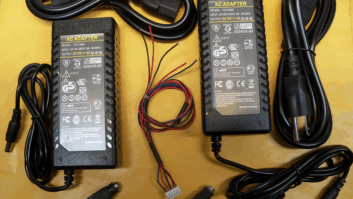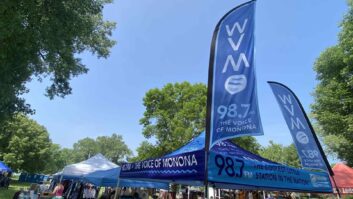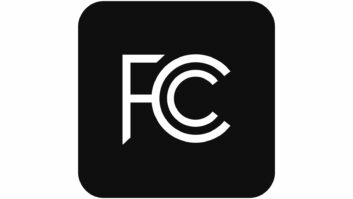
Entercom believes KEZW is the largest U.S. radio station with facilities powered by the sun. Less than a year after groundbreaking at Entercom Denver’s KEZW(AM) transmitter site, ribbon-cutting ceremonies were held in October to mark the startup of a 100 kW solar array that powers the station’s transmitter and related equipment.
The company believes this makes KEZW the largest radio station in the United States to be powered by the sun. It says its monthly energy costs have dropped by 80 percent.
What sets KEZW apart from other such installations is the scale of its operation.
“A lot of stations say they’re powered by wind or solar,” said Jeff Garrett, director of engineering for Entercom Denver. “But that usually means a part of the energy comes from renewables, or it is a low-powered station.
“Our solar array is able to power the transmitter site 100 percent on most days when there is sufficient sunlight.”
Even in late October, the array was able to power the site fully. KEZW operates on 1430 kHz with 10 kW day and 5 kW night using a Nautel MD-10 transmitter driving a five-tower array.
Commitment and space
A number of pieces need to fall into place in a project of this scale. Most important, according to Garrett, is a commitment from top management to get the job done.

Entercom CEO David Field and Director of Sustainability Jamie Field discuss the array project with Denver DOE Jeff Garrett. “A lot of companies speak the words about going green, but Entercom’s management has consistently backed energy saving programs that work.” The company said the project is part of an environmental initiative called 1Thing, as in “do one thing to improve the environment each day.”
KEZW also was fortunate in having the necessary real estate. There was plenty of land at the transmitter for the 300-by-80-foot solar array.
Also important are federal and state tax incentives for renewables. “Everyone is in favor of renewable energy, but they’re also looking at the bottom line. Anything that drives down the upfront costs will make the project more attractive.”
Ken Beck, vice president, technical operations and news, talk and sports programming for Entercom, said, “We were able to participate in a now-expired federal program which allowed certain facilities to qualify for a federal cash incentive instead of a tax credit. The state of Colorado also has a repurchase program through the local utility, which helped make this project work for us.” He speculated that this financial landscape might change in the future because a lot of the incentive programs at the local and federal levels came under scrutiny during the so-called fiscal cliff discussions.
The station also needed to consult state laws. “The largest system we were allowed to build was 130 percent of our rated load,” said Garrett. Such legislation prevents organizations from becoming independent power companies.
The solar project isn’t the first energy conservation initiative at KEZW. Five years ago, the lamps in the five AM towers were replaced with LEDs.
“I had to rewind the toroids so we could get enough power to drive the remote control sensors,” said Garrett. He adds that before the LED upgrade, the station used about 7 kW of power per year just to light the towers.
Concerns
Garrett had built a wind- and solar-powered facility at KFMU(FM) in Steamboat Springs, and while he was enthusiastic about this solar project, he had several concerns.

An unidentified technician from REC Solar installs inverters on the wall of the transmitter building. “I wasn’t sure about storing the energy, and how batteries would work at the scale we were planning. Also, the interactions between AM array and solar gear were a concern.” How would a strong RF field affect the inverters? How would the solar-panel array influence the AM pattern?
Garrett and staff engineer Derek Jackson conducted some experiments and did the preliminary work. Inverters were delivered to the transmitter site and tested. They delivered a clean sine wave output, and didn’t seem to be sensitive to RF. Before construction, the engineers did a partial proof so there were baseline measurements of the AM pattern. They consulted the site’s blueprints and marked out ground radials and other buried cables so there would be no accidents while holes were being dug for pilings.
As plans progressed, they decided to forego battery power and simply feed the inverters directly into the grid. This meant the station would be on the grid during nighttime hours; but it also simplified the installation, allowing the power grid, emergency generator and solar array to work together harmoniously.
The utility company installed metering equipment at the site to track how much power KEZW was contributing to the grid. The solar array generates 100 kW of power, and 85 kW are available from the inverters.
REC Solar of San Luis Obispo, Calif., was hired as the general contractor, and Hatfield & Dawson Consulting Engineers of Seattle were signed on to develop a plan to preserve the integrity of the AM pattern as the solar array was installed.
“Basically, we had to cadweld grounding pigtails to everything and tie it all onto a copper strap that connected to the AM ground system,” said Garrett. Some minor retuning of the AM array was necessary as construction trailers were on site. After work was completed, the site was retuned, and the settings matched the original numbers.
Another concern was the effect on the solar system of load switching from the 10 kW day to 5 kW night patterns, but that turned out not to be a problem.
Garrett and Jackson’s testing, planning and hard work paid off.

The sun bathes solar panels being installed between snowstorms in early 2012. “The solar system has worked perfectly from day one. The efficiency of the new inverters and solar cells is impressive. Many days we are generating more power than we are using.”
The real payoff however is in the bottom line. “Last year our electric bills for the transmitter site were $1,200–$1,300 [monthly]. This year, for July and August, it dropped to $270.” And that’s in addition to earlier power-bill savings from installing LED beacons.
Tom Vernon is a longtime contributor to Radio World. He wrote about graphics for radio in August 2012.
Has your station adopted notable “green” practices at your facility? Tell us about it at [email protected].







